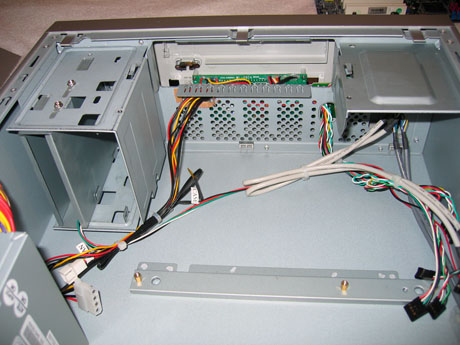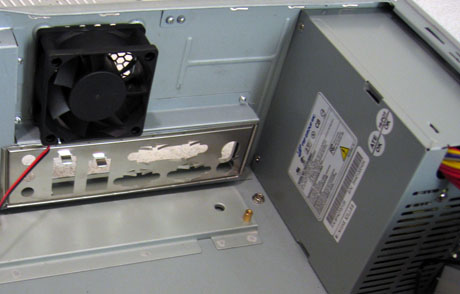December 2004 HTPC Case Roundup
by Purav Sanghani on December 27, 2004 2:00 AM EST- Posted in
- Cases/Cooling/PSUs
NMediaPC HTPC 100 (cont'd)
Finally, the last of our HTPC cases uses thumbscrews to secure the top panel. We unscrew the two thumbscrews to see if there are any tool-less features inside the case.Internal Design
From the outside, we could tell that it would not be able to support standard ATX boards, since the HTPC 100 chassis had such a small footprint, and we were correct. In fact, upon opening the top cover, we saw that the internal layout seemed extremely cramped, even for uATX boards!The drive bays in this chassis are designed a bit different than the others. To begin, the 3-1/2" drive bays are positioned so that the drives will be mounted vertically. There are a total of two bays, but one is occupied by the flash memory card reader, which leaves room for only one HDD. There is also a single removable 5-1/4" drive bay in the middle part of the front of the case, which will be used for the optical drive.
The motherboard tray, of course, will only support uATX boards due to the small size of the chassis. We should expect to see other manufacturers design HTPC cases to support only the smaller components in time.
The expansion slots use standard screws in the HTPC 100 chassis also. We were certain that NMediaPC would carry the thumbscrew idea to the inside of the chassis, but were disappointed to find otherwise. Hopefully, future models will carry more tool-less features and we shouldn't be too sour, since HTPCs have only just entered the market.
Cooling
With the HTPC 100 chassis being as small as it is, many would think that there may not be a need for many fans to cool the system. NMediaPC has included only a single 60mm fan mounted at the back of the case where we have seen a pair in the first 3 HTPC cases. We will see if this single fan is indeed enough to compete with the rest of the cases.The HTPC 100 also comes with a 270W FSP silent power supply almost identical to the SilenX unit in the D.Vine 5, but the obvious lower power output.
Construction
The HTPC 100 chassis combines plastic and steel in its construction. The front bezel is entirely plastic, but has an excellent glossy paint job to give it anything but a bland look. This glossy paint is also carried to the rest of the outer shell of the chassis.The rest of the shell, as well as the internals of the case, is constructed from 0.8mm steel. We did not find any sharp edges inside the case around the drive bays or anywhere else. NMediaPC's case manufacturer did a great job in folding over the edges.












34 Comments
View All Comments
monsoon - Wednesday, September 7, 2005 - link
hola,i want my HTPC to be a full fledged double-core AMD PC capable of running everything, with double 5'25" front bays and silent.
so, what'S out there today to realize such a project ?
it's been almost a year since this shoot-out, and i would really love to see some commercial products ( already assembled or cases only ) to match these needs.
120mm fans anyone ?
passive cooling ( or should we wait for the coming laptop double-core CPU releases ) ?
thanks for reading this,
cheers
rdunnill - Friday, January 28, 2005 - link
Quote: "There isn't anything requiring these large cases except a gaming video card"To the contrary, I use a Holo3Dgraph-I deinterlacing card, which is full-height and thus requires a modestly-footprinted case like the NMediaPC.
rdunnill - Friday, January 28, 2005 - link
I am considering the NMediaPC case due to its small footprint.Footprint barely received mention in the review, but it's important to me, because the space in my HT cabinet is small.
mindless1 - Thursday, December 30, 2004 - link
JKing76, the distinction is not "just playing movies". There isn't anything requiring these large cases except a gaming video card, or to look at it another way, stuffing so many cards in that you can't get a riser to work and need a larger power supply too. Perhaps if you need more than 2 HDDs, that's an issue too... but most won't.Games <> Home Theater
Some can't grasp that, and that's OK, there SHOULD be cases suitable for building living room gaming boxes, but that does not begin to mean HTPC cases per se, should be this large.
goku21 - Thursday, December 30, 2004 - link
What about doing a project/review on a HTPC you build yourself? Go all out and instead of using a HTPC case use a SFF case or something. Be a little different about it.That's something I'd like to see. Perhaps something interactive where all the readers can vote on what types of components go into it and what not.
Of course that's just my stupid opinion =)
PuravSanghani - Wednesday, December 29, 2004 - link
We gave our Editor's Choice Award to the SilverStone LC10/M because it has a combination of great features (VFD Text display, room for expansion with more HDD mounting space, the ability to install a full ATX board and power supply, as well as an optional multimedia kit since MS Windows Media Center is not sold on store shelves just yet). Bias is not one of the reasons we chose the LC10.The HTPC100 is a great out-of-the-box solution if you want a simple barebones system. It performed well in our thermal and sound benchmarks. The case, however, does not have much room for expansion, only supports microATX boards, and does not have a text display. Although, for its performance in thermal and sound we believe it is a worthy competitor to the LC10.
We hope this clears up some confusion in our regarding our conclusion of this roundup.
-----
Nintari, Mindless, mcveigh: We chose these components because many boxed Home Theater PCs come with hardware similar to our configuration. A media center PC, in our definition, is not just a PC with a TV Tuner slapped in it, but rather a fully functional PC with the ability to process home theater content.
Definitions of the HTPC will vary by user and the purpose of the HTPC in their home theater setup.
During our testing we do not install a TV Tuner card but we do process content like playing a DVD and video games to simulate operations during normal PC use with this "standard" hardware.
-----
#27: Feel free to let us know of any errors in the article and we will be more than happy to fix them. Thanks.
Purav Sanghani
Clint - Wednesday, December 29, 2004 - link
All three vendor links for the Silverstone case show a completely different case (though they all match one another).ElFenix - Tuesday, December 28, 2004 - link
I've asked for years: please hire an english major to edit your articles. The sentence structure of this article is even worse than most of the articles around here.JKing76 - Tuesday, December 28, 2004 - link
Sorry mindless, I don't buy your definition of HTPC. I consider an HTPC to be a computer you'd keep hooked up to a home theater system full time. You want a tiny, low-power PC just for playing movies, well, that's your choice. But there's no reason big screen, high-quality surround sound gaming support can't be part of a HTPC.geogecko - Tuesday, December 28, 2004 - link
Personally...the best HTPC case money can buy...http://www.atechfabrication.com/products/heatsync_...